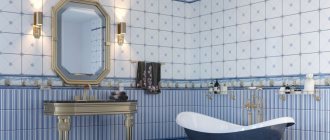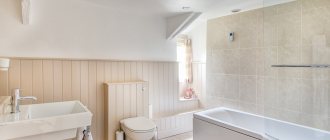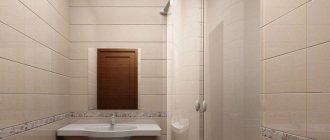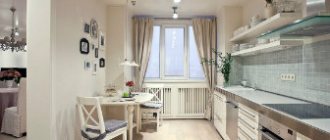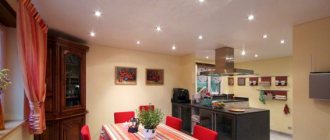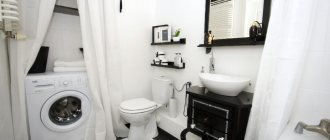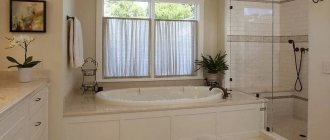Home » Home Improvement » Ceilings
Ceilings
Alyona
19450 Views
Plastic, as a finishing material for ceilings, is now becoming increasingly widespread. If we compare it with other types of ceiling finishing, this method will cost more than materials and installation work used in other cases. However, the subsequent cost of operating the plastic ceiling covering itself will be significantly lower.
The concept of plastic ceilings includes specific types of ceiling coverings - Armstrong, Grilyato and others similar. Installation diagrams and suspended structures assembled from simple load-bearing elements and plastic panels of various sizes and colors have been specially developed for them. There are a huge number of different instructions explaining the correctness and sequence of assembling such ceilings.
Plastic after installation does not require any additional processing of the front surface. Even with very heavy contamination with soot and soot from gas stoves in kitchens, plastic easily restores its original decorative qualities and color scheme. This is ensured by simple washing with plain water and soapy water.
Plastic as a finishing material for ceilings
PVC plastic is hygienic, under normal conditions it does not emit any chemical fumes harmful to humans, and is resistant to biological contamination in the form of rot, mold and fungus. Its destruction begins to occur at temperatures not lower than 120 degrees Celsius.
On both sides of the coin: advantages and disadvantages of plastic panels
Well, how can we do without the usual analysis of the material? No way! We consider it our responsibility to talk about all the nuances and qualities of the product, because highlighting only the advantages and hiding the disadvantages is simply ugly!
Pros:
- strength;
- long service life;
- plastic;
- moisture resistance;
- resistance to ultraviolet rays;
- easy cleaning job;
- installation allows you not to worry about leveling the ceiling;
- acceptable price;
- large range of products;
- Possibility to install panels yourself.
The material allows you to install electrodes, halogens, and lamps in direct contact with the product. Any wires will run out of human visibility.
The drawing allows you to focus on areas of the room. You can simply find panels with a pattern that creates an optical effect
Installation work is extremely simple and does not require large tools.
Minuses:
- reducing the height of the walls by several centimeters;
- the need to install a frame;
- a small number of textures and textures.
As we see, there are no significant shortcomings.
Installation methods
You can decorate the ceiling with panels of various types. Before starting work, all your actions must be carefully planned. It should be noted that products may differ in thickness, width, appearance of the front part, and fastening features. There are several ways to attach structures to the ceiling:
- Cassette suspension. Decorative modules and various profiles are mounted simply and quickly on pre-prepared guide rails;
- Rack mounting. Installation is carried out on a special frame. Rack profiles are adjusted to size. Lean it against the ceiling and snap it into place with the tire fasteners;
- Gluing. The method is suitable for lightweight polystyrene, laminated, extruded boards. For fastening, it is better to choose special compounds, but simple PVA or Moment glue will do. You can create the effect of a seamless ceiling by treating the joints with silicone sealant;
- Tongue-groove system. With the help of a locking connection, the elements are easily and reliably joined, creating a smooth surface. They are mounted on a wooden sheathing. Installation does not require leveling the walls. The mounting method is suitable for plastic and MDF models.
What types of PVC ceiling panels are there?
At the moment, there are three main types of plastic panels: slatted, tile-like and sheet. In general, it is more convenient to divide PVC products by shape and texture, size and color. The traditional size is from 20 to 50 cm in width and from 5 to 10 mm in thickness.
Surface can be matte or glossy
The length of the products is selected taking into account the room and ranges from 2.6 m to 6 m.
The color range is not yet presented in a wide range, but the presented shades and patterns are already enough for a good choice
Related article:
PVC panels. In the publication we will look at the advantages and disadvantages, types, sizes, characteristics of ceiling and wall products, average prices, selection criteria, and the nuances of do-it-yourself installation.
Tips for choosing
The variety of types and shapes of panels makes their choice difficult. First of all, you should decide on the material of manufacture. It should match the overall interior of the room, wall and floor decoration. In order for the structure to last for a long time, the choice should be made taking into account the characteristics of each type:
- Plastic plates must be smooth with a clear geometry and uniform distribution of the pattern. To ensure sufficient strength, the element must be squeezed with force with your fingers;
- Wooden products should not have cracks or chips. For each type of wood, small errors are acceptable, which reduces their cost. But it is better to use elements with a clear pattern, without burrs, scratches, or blue stains;
- Foam blocks should be selected only with a smooth, clear, identical pattern over the entire surface. High-quality tiles do not break when dropped or lightly shaken;
- 3D panels have various characteristics and features. When giving preference to this type of finishing, you should take into account the purpose of the room. These can be natural models, fireproof, moisture resistant;
- Aluminum parts must have a minimum thickness of 0.5 cm. If they are thinner, the structure can quickly deform at the initial stage of operation.
Ceiling design made of plastic panels in the kitchen, bathroom and hallway with photo examples
The choice is determined by the specifics of the premises and the preferred design. If you can install a dark ceiling in the hallway, then for the kitchen you should consider white, cream, beige, soft blue and light green colors.
Advice! If the room is small, then pastel shades will not visually steal a centimeter.
The moisture resistance of the material is ideal for the kitchen: the design with such a ceiling is charming
Any colors will look good in the bathroom if they match the tone of the walls
In the kitchen, plastic lining looks good and is very easy to clean
Small hallways look neat with this decoration. And the non-standard texture seems to turn everything upside down
Related article:
Photos of floating suspended ceilings. What is a floating ceiling? What is unique about this design? Lots of photo examples and installation nuances in a special publication.
Examples of application in the interior of an apartment/house
Classic cassette panels made of natural wood always remain stylish. Even an inexpensive analogue will look beautiful and aristocratic. The slatted finish in light colors will fit perfectly into the Scandinavian style and minimalism. This interior is suitable for a small apartment or a spacious country house.
Acrylic tiles will look good in any room. This is a universal material for the bedroom, toilet, kitchen, hallway. Economical plastic and wooden lining will create a beautiful, smooth ceiling, even on an uneven surface. The white foam finish will fill any room with light and lightness. Using ceiling panels, you can create a surface in a restrained, classic style or assemble a complex multi-level structure with designer lighting.
How to choose plastic panels - recommendations from our editors
If you haven’t found your name on the Forbes list this morning, but you really want to do some repairs, then choosing plastic panels for it will probably be the most suitable option. It’s really inexpensive, beautiful, and quite feasible even for a person without any skills in interior decoration.
In the catalogs of construction and finishing stores you can always find a variety of PVC models
What to do to avoid wasting money:
- Did you see a beautiful product? Close your eyes to this and study its quality: is the shape even, are there any waves, deflections, creases, dents? Or maybe there are chips along the edges? If so, then put it aside and look further!
- take the panel with the front side facing you and try to look at it through the light source - the transverse partitions of the cells should not be noticeable in the light;
- the more stiffening ribs, the stronger the model;
- press on the product: if there is no dent or crease, then the quality is fine.
The main question: how much does it cost to cover the ceiling with plastic panels? To answer, you need to take into account the availability of working tools in the house and the price of the material itself
How to make a ceiling from plastic panels on a frame
The material has been purchased, extraneous furniture and people have been removed from the room, it’s time to start installing a ceiling made of PVC panels with your own hands! The sequence of work consists of preparing and installing the frame and installing the panels themselves. To help with clarity, we suggest watching a video on installing a ceiling made of PVC panels with your own hands:
Assembling a frame from guide elements
First, prepare the working surface: the old ceiling is cleaned of dirt or previous finishing material. Next comes the stage of marking the frame: you need to draw a line that you should follow when attaching the profile. The markings are made on a sheet of paper: the lathing is made with a light CD profile. The ideal step between the cross bars is 60 cm.
The work can be carried out by one person
For installation you will need a drill and dowels: keep in mind that it takes 1 dowel per half meter of profile and 1 self-tapping screw per half meter of panel.
Nuance! If a wooden frame is used, you can use 6 mm staples instead of self-tapping screws.
Fasteners for the horizontal profile must be installed around the entire perimeter: rigid UD guide profiles are placed on the dowels. The transverse frame is installed on U-shaped fastenings
Important! The work is based on the building level, which will not allow the frame to be made askew.
Installation of PVC panels on the ceiling
After installing the frame, all that remains is to find out how to attach PVC panels to the ceiling. The installation takes little time, and the job is also easy to do. If you have the necessary tools, then after installing the frame you can immediately begin further assembly. It is better to prepare a new hacksaw and a soft simple pencil in advance.
Do-it-yourself suspended ceiling made of plastic panels
PVC sheets are cut to the required length, if required, taking into account that the length of each panel should be 5 mm less than the distance between the two walls. Installation is carried out starting from the window. First, fastening strips are attached to the profiles, into which skirting boards can be installed.
The first sheet is pushed into the opening formed between the baseboard and the profile strip. Fastening is done using a self-tapping screw with a wide head.
Now the work goes like clockwork: each panel slides into the groove of the previous one and is attached with self-tapping screws to the frame
After installing the last panel, the work is considered completed: you can put everything in order.
Related article:
Stretch ceiling in the bathroom. The pros and cons of using this type of ceiling, installation secrets and care recommendations are in a separate publication on our portal.
Self-installation
Installing plastic ceilings with your own hands can be done by a contractor who does not have any experience in performing such work. Self-cladding of any type of ceiling with plastic does not require specially purchased tools. Screwdrivers, drills, hacksaws, hammers, levels and plumb lines are always at hand for any home craftsman. All materials traditionally used for this purpose can be easily processed and adjusted to the required dimensions.
- To install plastic, it is enough to familiarize yourself with the work technology and study the recommended order of operations.
- Next, you need to prepare materials and get your tool into working condition.
- In order to minimize overspending and limit leftovers in the form of scraps, a preliminary calculation of the required amount of materials is performed. This is done using concepts from a high school geometry course. These include width, length, height, methods for measuring the areas of plane figures, their addition and subtraction, Pythagorean theorems of sines (cosines).
- Further, the contractor who performs the work on cladding and finishing ceilings with plastic will only need accurate calculations and accuracy.
You can install it yourself
Advice: Don’t forget about the use of protective equipment - glasses, respirators, workwear. To protect your head from falling objects from above, you will need a standard construction helmet. And in general, when finishing the ceiling with plastic, one cannot ignore safety requirements and fire safety measures.
Reliable stepladders and scaffolding must be in demand. During work, it is recommended to invite an assistant who, in addition to providing services in auxiliary work, will be able, if necessary, to provide first aid during accidental mechanical injuries or electric shock.
What you can make from plastic bottles with your own hands (+185 Photos). TOP 12 step-by-step instructions
How to attach plastic panels directly to the ceiling
Attaching PVC panels to the ceiling can be simply glued if the conditions are suitable:
- Smooth surface;
- relatively dry room.
If the room is completely dry, then purchase glue for plastic, which is applied to the panel. It is simply glued to the ceiling, starting from the corner near the window of the room. If the room is exposed to moisture, then fastening can be done using “liquid” nails. At the final stage, a ceiling plinth is attached around the perimeter.
Features of installing spotlights in a ceiling made of plastic panels
When choosing a lamp, do not forget that plastic can melt from excessive heat. This is why incandescent light bulbs and gas-charging lamps are not suitable for installation in PVC sheet ceilings. But 40 W LED lighting would be appropriate.
Lamps can be an interesting highlight
Expert's point of view
Dmitry Kholodok
Technical director of repair and construction
Ask a Question
“Choose light bulbs that have a sealing level of IP44 or higher.”
Important! The number of lamps for one transformer is 4 pieces - with a wire length not exceeding 250 cm.
It is better to start lighting work before the ceiling is completely assembled
To install lighting, prepare everything you need in advance: wires, lamps, electrical tape, terminal blocks, switches. Having determined the location of each lamp, markings are applied to the ceiling. It is important not to get on the joints of the panels or on the profile.
If there is no drill with a suitable attachment, then use a compass and a stationery knife. All work on making holes is carried out without pressing on the plastic! Working with a stationery knife, make a cut inside the circle.
Important! Drill only on an uninstalled panel!
We insert the lamp into the hole, snapping it onto the springs. Do not forget that work with wires is carried out only with the voltage turned off in the entire house. The wires are exposed and connected to the cartridge
Features of operation and care of plastic ceiling panels in various rooms
Although plastic is not a capricious material, it nevertheless also requires care. According to the specifics of the room, the method of cleaning the ceiling is also selected.
Ceiling made of plastic panels in the bathroom, toilet and kitchen
The bathroom, kitchen and toilet are rooms with high levels of humidity. The moisture resistance of PVC panels was already mentioned above, but it was not stated that such products do not need to be used correctly.
A clean ceiling is impossible without maintenance
Grease can get on the ceiling and remain there as yellowish-brown frozen droplets that are not so easy to wash off. Therefore, you need to make it a rule to wipe the panels with a moderately damp cloth every time after cooking in a frying pan.
The bathroom also leaves its mark on the panels: limescale leaves unsightly stains
You can wipe the ceiling made of PVC panels in the bathroom and toilet with a microfiber cloth or melamine sponge.
In any room you should carefully inspect the lining for dirt in order to remove it immediately
In the corridor, on glazed balconies and loggias
There is no cooking in the corridor, on the balcony or loggia, there is no steam, there is no high humidity: in such rooms, other than brushing off a certain amount of dust from the panels, nothing is required.
If you rub products with abrasive substances, they will quickly lose their attractive appearance.
In any room, it is important to do wet cleaning once every one and a half to two months, not forgetting about the ceiling covering
Pros and cons of the material
The main material for the production of ceiling panels is polyvinyl chloride; it is a very durable material that has a number of undoubted advantages.
- has a low cost - any average Russian can afford stylish cladding with PVC plates;
- is distinguished by its versatility - used in premises of any type, style and purpose;
- hygroscopicity – plastic does not absorb water, is resistant to the adverse effects of the external environment, does not deform or sag under the influence of humidity and temperature changes;
- the material is impact-resistant and wear-resistant - it is not damaged due to impacts of medium and low force, but, of course, if you hit such a coating with all your strength with an ax, it will break, but the material is reliably protected from minor scratches and chips;
- the long service life of plastic is well known - if the product is of good quality, then the most unpleasant thing that can await the owner of a plastic ceiling over time is an insignificant change in color, and even then only in cases where it is under constant exposure to sunlight;
- PVC panels are resistant to aggressive acid-base compounds, they can be easily washed with any cleaning agents;
- the material is characterized by good sound insulation and is an excellent choice for those who love peace and quiet;
- PVC panels are not afraid of floods - if your neighbors unexpectedly flood you, the panels can be easily removed, dried and hung back;
- If one of the panels loses its original luster or breaks, it is easy and simple to replace; such repairs do not require replacing the entire ceiling covering.
However, the material is not without its shortcomings. In particular, the ceiling cannot be installed in rooms where high air temperatures are constantly maintained. In such conditions, the coating quickly deforms, and there will be no way to repair it. Plastic, especially if it is of low quality, can release harmful and toxic substances. That is why you should avoid using it in bedrooms and children's rooms.
Review of prices of plastic ceiling panels depending on type and size
Not everyone wants and not everyone can install a ceiling from PVC panels on their own. It’s easier to find out what the price is for work at the nearest house and apartment finishing company and, with the help of the employees, cover the ceiling with plastic panels without any problems.
You can buy plastic panels for the ceiling either online or simply by visiting a nearby hardware store.
In the catalogs you can find panels as both ceiling and wall coverings
On average, a ceiling made of plastic panels costs from 100 rubles per piece and, accordingly, less than 400 rubles per m2. But panels are bought either in packaging or individually.
Happy ceiling renovation!
Standard sizes
Plastic panels for suspended slatted ceilings are different. They are sold in packs of 6 pieces. Typically their thickness is 1 cm. In some varieties it is thinner (0.9 mm). The width of the stripes can be 100, 200, 250 cm.
Wide varieties are especially good: they give more scope to imagination. Their texture looks good together with the stretch fabric. The use of matte and glossy coatings of large width allows you to create a design with a transition on the wall. This way you can highlight one of the functional areas of the room.
The length of the stripes is also variable. The standard dimensions are 270, 300, 400 and 600 cm. The presence of different sizes allows you to select coatings accurately, minimizing overruns. Varieties with a length of 4 meters and a maximum width allow you to design the ceiling quickly and accurately. To make them look advantageous, they are complemented with stretched fabric in a contrasting color.
6-meter strips are used in industrial premises with a large area. There is no need to use such products for your home or apartment. For these purposes, strips of 250x270, 250x300 cm are sufficient. Sometimes wide panels are combined with narrow ones, placing them in different directions.
